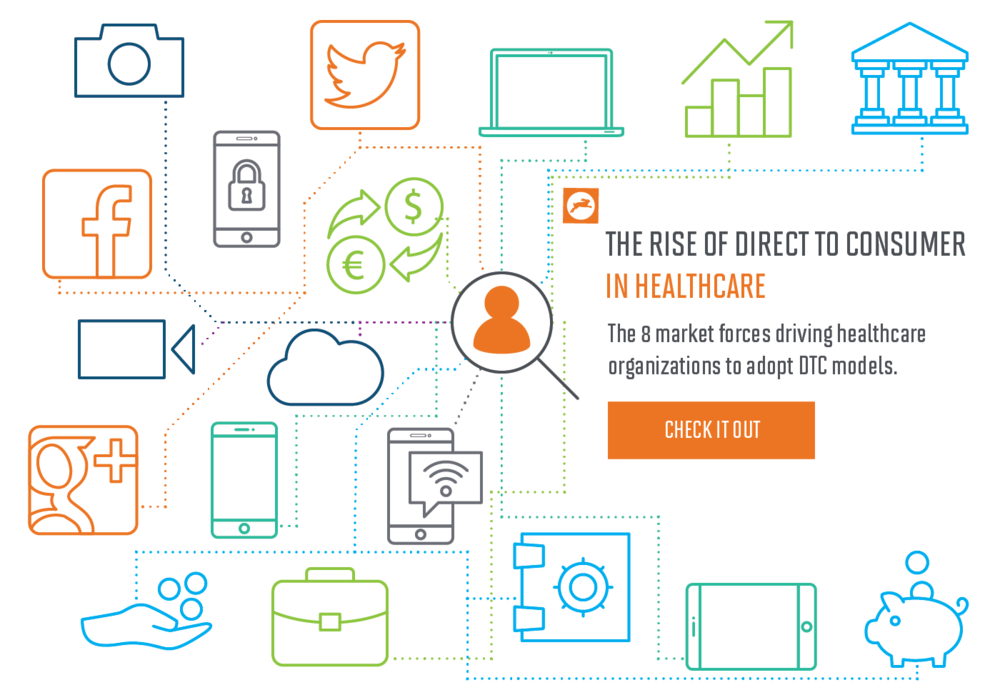The 8 Market Forces Leading to the Rise of Direct-to-Consumer Models in Healthcare
The global consumer health product market is expected to reach $290B by 2020, rising from $217B in 2016 according to Euromonitor International. Looking to take advantage of this growing market, there has been a surge in direct-to-consumer (DTC) healthcare ventures that are selling healthcare products and pharmaceuticals directly to consumers.
Below we’ve put together the 8 market forces we’ve determined are influencing the healthcare DTC expansion:
Consumer and Payer Acceptance of Telemedicine
Telemedicine is gaining acceptance by patients and payers. According to Transparency Market Research, the global telemedicine market was valued at $6B in 2016 and is projected to have a CAGR of 13% from 2017-2025. In the US specifically, the market is projected to grow 14.8% to reach $2.8B by 2025. In a survey conducted by Kaiser Permanente of patients who had received a telemedicine visit as part of their care, 93% of patients reported that their telemedicine visit met their needs. Additionally, beginning in 2019, under HCPCS Code G2010 and G2012, physicians can now be reimbursed for reviewing stored video or pictures that a user uploads and for quick virtual check-ins. This allows for consumers to receive prescriptions to treat issues that can be diagnosed through video, picture, or a quick check-in.
Increasing Number of High Deductible Health Plans
While some reports indicate that the prevalence of high-deductible plans are decreasing, a recent survey by the CDC found that nearly half of the private pay US pre-medicare population were on a HDHP in 2018, over a three percent increase from 2017. These plans leave patients hesitant to receive care as the costs are unpredictable, and can leave many struggling to pay the associated bills. In a recent survey by West Health Institute that set out to understand Americans’ view of healthcare costs, forty percent of respondents reported skipping a test or treatment over the last year due to cost. Additionally, nearly a third of respondents reported that paying for health care causes them to have difficulty paying for basic necessities such as food and heat. Patients are skipping treatment due to the unclear costs associated with receiving treatment, and seek services with transparent pricing.
Low Primary Care Provider Relationships
A poll conducted by the Kaiser Family Foundation found that 45% of 18-29 year olds did not have a primary care provider, but only 18% of those from 50-64 years old did not have a primary care provider. Many millennial patients do not have a trusted provider that they can use to navigate through the rest of the healthcare system.
Delivery to Door Services
In the past, patients had to go to a doctor’s office for a care, and then to a neighborhood pharmacy in order to pick up their prescription. Now, with changes in telemedicine and prescription delivery, a patient can have a physician consultation and obtain a prescription without leaving their house (due to ventures such as ScriptDrop and PillPack).
Direct Marketing Capabilities
With the rise of the ability to target very specific people on social media using Facebook, Twitter, and Instagram, direct to consumer companies can quickly and cost efficiently reach their target audience. Google and Facebook analytics help these companies easily make the appropriate changes to their marketing strategies to get more people to their site and ordering their products.
Tech Cutting out The Middleman
Technology allows for ventures to cut out middlemen that would lead to a mark-up in the price of a product and add a step for a patient to have to go through in order to have access to a product or drug. Now, companies can ditch retail stores and coordinate direct delivery.
Demand For Improved Customer Experience
A report by Vitals indicated that thirty percent of people have walked out on a scheduled physician appointment due to wait time, with wait time being a large determinant of the patient experience. Customers are growing accustomed to consumer experience being seamless with organizations such as Netflix, Lyft, or Amazon. The traditional healthcare system has not kept up.
Affective Concerns
According to a study looking at why people avoid medical care, a significant amount of people reported avoiding medical care for reasons that include what the researchers labeled “Affective Concerns”, which are barriers to care related to feelings such as guilt, fear, or embarrassment. These feelings lead to treatment gaps that the traditional healthcare system alone can not close, but that DTC is helping to ameliorate.
WORKS CITED
1. Transparency Market Research. Global Telehealth Market to Reach US$ 19.5 Bn by 2025; Improving Services and Increase in Applications of Telehealth to Boost the Market. (2018). https://www.transparencymarketresearch.com/pressrelease/telehealth-market.htm
2. Reed, M. E., Parikh, R., Huang, J., Ballard, D. W., Barr, I., & Wargon, C. (2018). Real-Time Patient–Provider Video Telemedicine Integrated with Clinical Care. New England Journal of Medicine, 379(15), 1478-1479.
3. Centers for Medicare & Medicaid Services. Final Policy, Payment, and Quality Provisions Changes to the Medicare Physician Fee Schedule for Calendar Year 2019. (2018). https://www.cms.gov/newsroom/fact-sheets/finalpolicy-payment-and-quality-provisions-changes-medicare-physician-fee-schedule-calendar-year
4. Cohen, R.A., Martinez, M.E., Zammitti, E.P.(2018) Health Insurance Coverage: Early Release of Estimates From the National Health Interview Survey, January–March 2018. https://www.cdc.gov/nchs/data/nhis/earlyrelease/Insur201808.pdf
5. Benz, J. , Titus, J., Tompson, T., Leitz, S., (2018) Americans’ Views of Healthcare Costs, Coverage, and Policy. Norc University of Chicago.
6. Kirzinger, A., Munana, C., Brodie, M. Kaiser Family Foundation. One-Fourth Of Adults And Nearly Half of Adults Under 30 Don’t Have A Primary Care Doctor. (2018). https://www.kff.org/other/slide/one-fourth-of-adults-andnearly-half-of-adults-under-30-dont-have-a-primary-care-doctor/
7. Larson, G. 9th Annual Vitals Wait Time Report Released. (2018). https://www.vitals.com/about/posts/presscenter/press-releases/9th-annual-vitals-wait-time-report-released
To learn more, download the complete report, click here.





